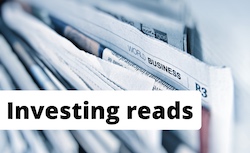What caught my eye this week.
Hard to believe it’s more than ten years ago that I wrote – slightly tongue-in-cheek – about how I was betting against Neil Woodford.
The then-lauded fund manager had just handed back the reins of the Edinburgh Investment Trust – one of several funds he ran as Invesco’s superstar manager – because he was opening his own fund shop.
Edinburgh’s share price fell from a 5% premium to trade at a discount to NAV in response.
But I reasoned:
Sure, a few [other] income investment trusts are on a discount, but my point is it’s clearly possible to run an income trust and be well-regarded enough for investors to pay more for shares in your trust than the value of its assets, even if your name is not ‘Neil Woodford’.
And my bet – and the reason I bought the shares after the sell-off – is I believe the same will likely be true of the Edinburgh trust at some time in the future.
In fact, I wouldn’t be surprised if the premium even comes back before Woodford has left in April!
Okay, it took until August – but I was right and it was a nice little trade.
However I kind of missed the wood for the trees.
Woodford’s stock
Most readers will know Woodford’s new venture went on to collapse within just a few years. It left a trail of broken-hearted followers in its wake. As well as a legal kerfuffle that was still dragging on this year.
Here’s a podcast recap from A Long Time In Finance. Or take your pick of two books written about Woodford’s rise and fall.
I can’t say I predicted this disaster in my 2013 piece. Although to be fair, who honestly could have?
The scale of the drama, anyway.
Me, I even admitted I thought Woodford had as good a claim as any to investing edge.
Although thankfully – and more on-brand – I said we couldn’t be sure. Even 25 years of outperformance at Invesco – which had made him the darling of middle-England savers – wasn’t definitive evidence of skill versus luck.
Also, I wrote:
I don’t think you should spend your time looking for the next Woodford though, any more than I think you should bet your two-year old grandson is going to be the next David Beckham.
Some scant few of us are touched by the gods of fortune, but you surely don’t want to gamble your retirement on it.
That second line is pretty portentous in light of what happened next.
Hey brother, can you spare a follow?
One person who is definitely not looking for the next Neil Woodford is… Neil Woodford.
Because the fund manager this week relaunched himself as a financial influencer.
Writing on his new blog, Woodford says:
My name is Neil Woodford. I am 64 years old, and I live in southwest England. I have worked in the investment industry since the early 1980s. You may remember me as the fund manager who avoided the dot-com bubble and the banking crisis and delivered index-beating performance for over 25 years, or perhaps as the ‘disgraced’ fund manager who presided over Woodford Investment Management’s collapse in 2019. Others may not have heard of me at all. Whatever your perspective, you may be curious about what I have to say about a wide range of economic, social, and political issues that impact our everyday lives.
Unfortunately, much of the commentary I read about the UK economy is long on opinion but critically short on data. It is often factually wrong, perhaps because established narratives are too willingly accepted. What is clearly severely lacking is data-supported information and analysis.
The economic analysis and commentary in Woodford Views will focus on relevant facts and data without censorship from editors, pressure to toe a particular line or consensus thinking.
Well you’ve gotta admit the lad’s still got chutzpah coming out the Wazoo. There’s even a dose of 2024-style post-truth anti-mainstream posturing in there.
Only 93 followers so far on Instagram though. The struggle is real.
Glass fund houses
We can surely guess how those who’ve pursued Woodford in the courts feel about this development. Or those who lost money with his funds. Or, worse, who waited for years just to get their money back.
Me? I’m a complicated soul.
While it’s abundantly clear in hindsight that Woodford’s mixing of private and public assets was ill-advised in open-ended vehicles, it’s not like that hadn’t been done before. It still goes on today.
He was criticised too for loading up on unlisted holdings with his closed-end Patient Capital trust. But many investment trusts are languishing on discounts today in part likely because of their illiquid private assets, including giants such as Scottish Mortgage and RIT Capital Partners.
And while it’s now far harder to make the case for Woodford’ stock picking prowess in light of the disastrous run at his second venture, there is probably even another universe where economic circumstances turned differently and his contrarian bets were rewarded.
Not need to type angry comments at me! I know he earned millions selling himself as someone who could avoid such landmines but was ultimately paid for failure, given this disastrous outcome:

Source: Guardian
I’m just saying it’s a truism we only live through one reality but many other things could have happened.
If you like fund managers when they outperform, then you must at least acknowledge that such outperformance was possible because they – and you – took a risk that things would turn out far worse.
Sympathy for the devil
Even the likes of Buffett could have been wiped out in an alternative universe where, say, the US went to war with Russia in the mid-20th Century, or if his legal troubles of the early 1970s hadn’t been amicably resolved, or if a couple of key decisions during the Salomon Brothers scandal of the late 1980s had gone differently. And nobody’s track record is as a good as Buffett’s.
So yes, I too have read the stories of hubris and yes-man-ning in the Woodford Investment Management days. It all seems very off. I also agree it was ill-advised for him to go investing in blue sky nano-caps after making his bones – and his brand – as a large-cap fund manager.
But I can’t quite bring myself to write an apoplectic and hyperbolic op-ed about Neil Woodford the ‘finfluencer’ that would easily write itself.
(My co-blogger in contrast would surely have a field day.)
I don’t know, perhaps I think everybody deserves at least a chance of redemption.
I also recognise someone who can’t let go of a love of markets and the game. A fellow sufferer, perhaps?
Maybe it’s just the sheer brass balls of the man refusing to go quietly.
Or perhaps I pity anyone trying to make money from a new blog these days.
Why go there?
To be crystal clear, I understand anyone who splutters angrily at Woodford’s new venture. It’s almost surreal.
And I obviously don’t think anybody needs to invest money with Woodford or any other star manager.
Invest via a global tracker fund – or some other passive index funds – and you’ll never face being embroiled in fund manager drama ever again.
Have a great weekend!





